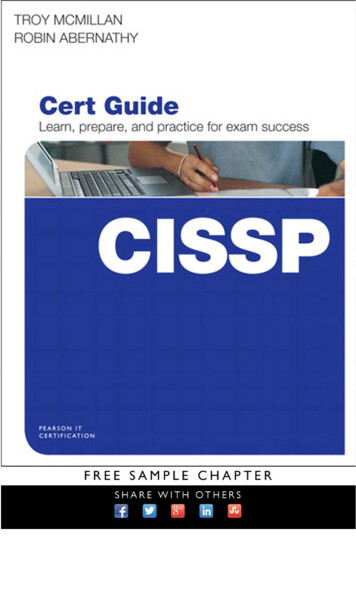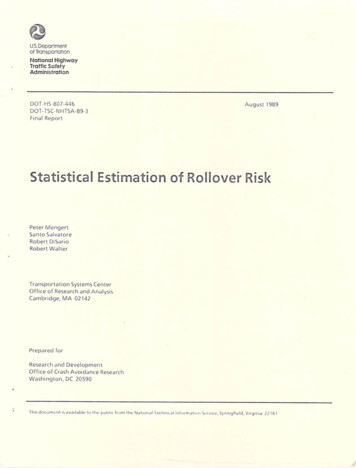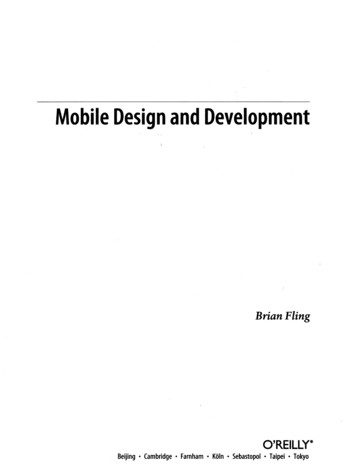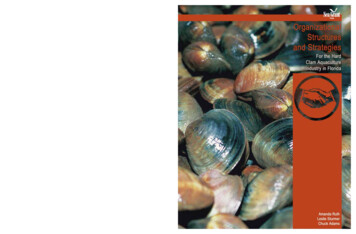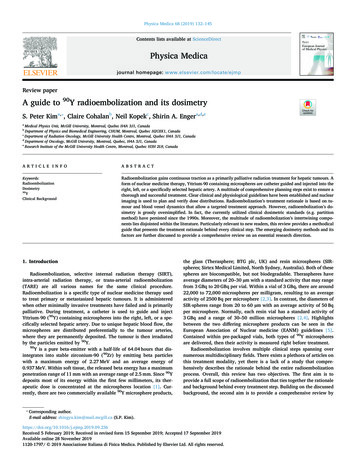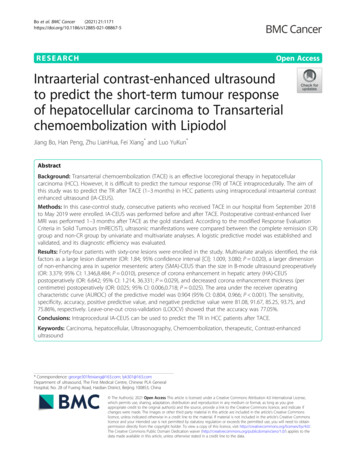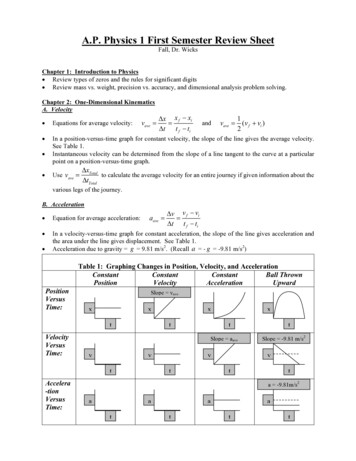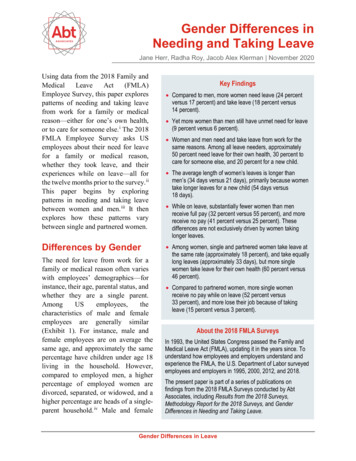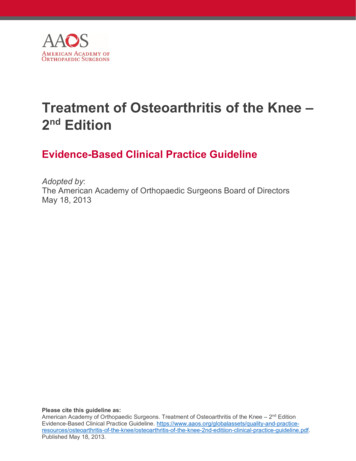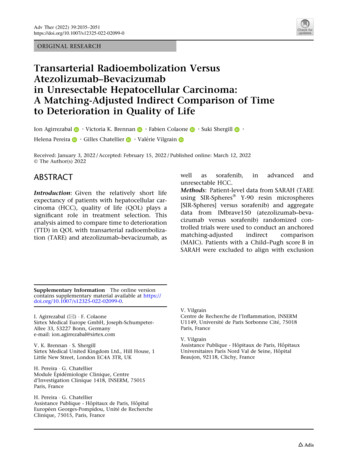
Transcription
Adv Ther (2022) 2099-0ORIGINAL RESEARCHTransarterial Radioembolization VersusAtezolizumab–Bevacizumabin Unresectable Hepatocellular Carcinoma:A Matching-Adjusted Indirect Comparison of Timeto Deterioration in Quality of LifeIon AgirrezabalHelena Pereira. Victoria K. Brennan. Gilles Chatellier. Fabien Colaone. Suki Shergill. Valérie VilgrainReceived: January 3, 2022 / Accepted: February 15, 2022 / Published online: March 12, 2022Ó The Author(s) 2022ABSTRACTIntroduction: Given the relatively short lifeexpectancy of patients with hepatocellular carcinoma (HCC), quality of life (QOL) plays asignificant role in treatment selection. Thisanalysis aimed to compare time to deterioration(TTD) in QOL with transarterial radioembolization (TARE) and atezolizumab–bevacizumab, aswellassorafenib,inadvancedandunresectable HCC.Methods: Patient-level data from SARAH (TAREusing SIR-SpheresÒ Y-90 resin microspheres[SIR-Spheres] versus sorafenib) and aggregatedata from IMbrave150 (atezolizumab–bevacizumab versus sorafenib) randomized controlled trials were used to conduct an anchoredmatching-adjustedindirectcomparison(MAIC). Patients with a Child–Pugh score B inSARAH were excluded to align with exclusionSupplementary Information The online versioncontains supplementary material available at https://doi.org/10.1007/s12325-022-02099-0.I. Agirrezabal (&) F. ColaoneSirtex Medical Europe GmbH, Joseph-SchumpeterAllee 33, 53227 Bonn, Germanye-mail: ion.agirrezabal@sirtex.comV. K. Brennan S. ShergillSirtex Medical United Kingdom Ltd., Hill House, 1Little New Street, London EC4A 3TR, UKH. Pereira G. ChatellierModule Épidémiologie Clinique, Centred’Investigation Clinique 1418, INSERM, 75015Paris, FranceH. Pereira G. ChatellierAssistance Publique - Hôpitaux de Paris, HôpitalEuropéen Georges-Pompidou, Unité de RechercheClinique, 75015, Paris, FranceV. VilgrainCentre de Recherche de l’Inflammation, INSERMU1149, Université de Paris Sorbonne Cité, 75018Paris, FranceV. VilgrainAssistance Publique - Hôpitaux de Paris, HôpitauxUniversitaires Paris Nord Val de Seine, HôpitalBeaujon, 92118, Clichy, France
2036criteria in IMbrave150. To identify potentialeffect modifiers for adjustment, the literaturewas searched and multivariate Cox proportionalhazards models were implemented usingSARAH data. Patients from SARAH were thenweighted to balance with baseline characteristics from IMbrave150. Median TTD in QOL andhazard ratios (HRs) were calculated.Results: Four potential effect modifiers wereidentified and used for adjustment: cause ofdisease (viral/non-viral), macrovascular invasion, Eastern Cooperative Oncology Groupperformance score, and alpha-fetoprotein level.The MAIC included 217 patients from SARAH(TARE 94; sorafenib 123). Median TTD inQOL was 11.23 and 8.64 months for atezolizumab–bevacizumab and TARE, respectively(HR 1.06; 95% confidence interval [CI]0.75–1.50; p 0.725). A sensitivity analysis wasconducted adjusting for cause of disease definedas hepatitis B/hepatitis C/non-viral: medianTTD in QOL was higher for TARE comparedwith atezolizumab–bevacizumab (19.88 vs11.23 months; HR 0.66; 95% CI 0.36–1.19;p 0.163). Sorafenib resulted in the shortestTTD in QOL, with statistically significant differences in both base case and sensitivityanalyses.Conclusion: TARE using SIR-Spheres mayachieve similar TTD in QOL compared withatezolizumab–bevacizumab, as the analysesfound no statistically significant differencesbetween these two interventions. Both TAREusing SIR-Spheres and atezolizumab–bevacizumab seem to be more efficacious than sorafenib in maintaining QOL.Adv Ther (2022) 39:2035–2051PLAIN LANGUAGE SUMMARYFor patients with hepatocellular carcinoma, aswell as physicians treating hepatocellular carcinoma, the quality of life that different treatments can offer represents an increasinglyimportant aspect to consider when choosingtreatments. Transarterial radioembolization andatezolizumab–bevacizumab are two potentialtreatments for advanced and unresectable hepatocellular carcinoma, but no clinical trials havedirectly compared the outcomes of these twotherapeutic options. With the data available(patient-level data from a clinical trial oftransarterial radioembolization using SIRSpheresÒ Y-90 resin microspheres [SIR-Spheres]versus sorafenib and data from a trial of atezolizumab–bevacizumab versus sorafenib fromthe literature), this study indirectly comparedthe time to deterioration of quality of life (i.e.,how long quality of life is maintained) aftertreatment with transarterial radioembolizationand atezolizumab–bevacizumab. The studyshowed that quality of life may be preservedover a similar time period with transarterialradioembolization using SIR-Spheres and atezolizumab–bevacizumab; also, both transarterial radioembolization using SIR-Spheres andatezolizumab–bevacizumab seem to maintainpatients’ quality of life over a longer period oftime compared with sorafenib. These results areexpected to enrich the existing evidence onwhich patients and physicians can base theirdecisions, allowing them to choose the mostappropriate treatment by assessing the treatments’ characteristics as a whole.
Adv Ther (2022) 39:2035–2051Keywords: Atezolizumab; Bevacizumab; EORTC QLQ-C30; Hepatocellular Carcinoma; IMbrave150; Matching-Adjusted Indirect Comparison; SARAH; SIR-Spheres; Sorafenib; Transarterial RadioembolizationKey Summary PointsWhy carry out this study?When life expectancy is short, quality oflife (QOL) is crucial for treatmentselection. Hepatocellular carcinoma(HCC) patients have a short lifeexpectancy, hence the importance of aholistic approach to treatment selection.The SARAH and IMbrave150 trialsinvestigated transarterialradioembolization (TARE) andatezolizumab–bevacizumab, versussorafenib, in HCC, but no clinical trialshave directly compared these twotreatments. This study aimed tounderstand the relative QOL outcomes ofthese treatments.What was learned from the study?This study indirectly compared the time todeterioration in QOL after treatment withTARE and atezolizumab–bevacizumab,and the results indicated that QOL may bemaintained over a similar time periodwith TARE andatezolizumab–bevacizumab. Also, bothTARE and atezolizumab–bevacizumabmay maintain patients’ QOL over a longerperiod compared with sorafenib.These results can potentially optimizedecision-making by both patients withHCC and physicians, when understandingtreatments’ characteristics as a whole is ofthe uttermost importance. These resultsshould, therefore, be considered inconjunction with other clinical outcomessuch as survival and adverse event profile.2037INTRODUCTIONThe World Health Organization defines healthas ‘‘a state of complete physical, mental andsocial well-being, not merely the absence ofdisease and infirmity’’ [1]. This definitionencourages moving away from the sole focus ofevaluation based on traditional outcomes suchas survival and morbidity, and the movetowards a holistic approach including additional measures such as of quality of life (QOL)[2].Quality of life is therefore an importantoutcome to consider, particularly in patientswith a short life expectancy, as maximizingtheir QOL could offer a substantial benefit totheir remaining time alive. Quality of life measures allow us to evaluate the impact of treatments on patients’ lives and enable informeddecision-making by both patients and clinicians[3]. This can improve patient experience, butalso support optimum treatment selection forpatients in an environment where there may beseveral treatment options available and morestill in development. Interestingly, severalpatient preference studies in oncology have alsodemonstrated how important QOL is forpatients with cancer, with some being willing totrade time alive for treatments with less negative impacts on their QOL [3–10]. Taking thisinto consideration a comparative analysis oftime to deterioration (TTD) in QOL for differenttreatments for patients with advanced andunresectable hepatocellular carcinoma (HCC)would provide valuable information which canbe used in treatment selection decisions.HCC is a cancer composed of malignanthepatocytes that develop in the parenchymaltissue of the liver, and is the predominant histology of primary liver cancer, accounting forapproximately 80% of all cases [11]. It is thesixth most common malignancy worldwide,with an estimated 905,677 new cases diagnosedin 2020 [12]. Although in some cases treatmentscan be curative, in Western countries a largeproportion of patients (approximately 50%) arediagnosed with later stage disease (BarcelonaClinic Liver Cancer [BCLC] stages C and D) thatis not amenable to potentially curative therapy
Adv Ther (2022) 39:2035–20512038[13]. Treatment selection in HCC variesaccording to disease stage: patients with BCLCstage 0/A disease are preferentially treated withpotentially curative therapies (resection, ablation, or liver transplant) that can be associatedwith long-term survival; on the other hand,patients with unresectable HCC (stages BCLC Band C) have historically been restricted to systemic therapy with sorafenib (Bayer AG, Leverkusen, Germany), or locoregional therapywith transarterial radioembolization (TARE, alsoknown as selective internal radiation therapy)or transarterial chemoembolization (TACE)[13].SIR-SpheresÒ Y-90 resin microspheres (SIRSpheres; Sirtex Medical Inc, Woburn, Massachusetts, USA) are a form of TARE consistingof resin microspheres containing radioactiveyttrium-90. They deliver radiation directly totumors through the hepatic artery, therebylimiting damage to normal liver cells. Positioning of TARE within the treatment algorithm isbased on results from two phase III randomizedcontrolled trials (RCTs), SARAH and SIRveNIB,comparing TARE using SIR-Spheres with sorafenib which show that SIR-Spheres results incomparable outcomes between the two arms(i.e., overall survival [OS] and progression-freesurvival [PFS]), while minimizing the impact ofadverse events [14, 15]. The results of theseRCTs were further supported by the conclusionsof a meta-analysis that demonstrated that TAREwith SIR-Spheres as initial therapy is noninferior to sorafenib in terms of OS, while offering abetter safety profile [16]. Additionally, a recentanalysis of the QOL data collected within theSARAH RCT found that TARE was associatedwith significantly better preservation of QOLand significantly delayed TTD in QOL relativeto sorafenib in patients with locally advanced,unresectable HCC (and including in patientswith macroscopic vascular invasion) [17].The first-line systemic treatment landscapefor HCC has changed substantially based onresults from the IMbrave150 trial where atezolizumab–bevacizumab(F.Hoffmann-LaRoche Ltd., Basel, Switzerland) demonstratedsuperiority over sorafenib for the first time interms of OS and QOL [18]. However, no headto-headcomparisonsofTAREwithFig. 1 Network of evidenceatezolizumab–bevacizumab have been undertaken and, to the authors’ knowledge, there areno data available to patients and clinicians onthe comparative impact of these treatments onpatients’ QOL. The current study thereforeaddresses this gap by undertaking an indirectanalysis of TTD in QOL of TARE versus atezolizumab–bevacizumab, using data of sorafenib as the common comparator across trials,and aims to generate results that allow betterdecision-making by both patients with HCCand physicians.METHODSData Sources and Analysis ProcessIndividual patient-level data (IPD) from SARAHand published, aggregate data from IMbrave150RCTs were used. Using sorafenib as the commoncomparator (Fig. 1), an anchored matching-adjusted indirect comparison (MAIC) was conducted to compare TARE using SIR-Spheres withatezolizumab–bevacizumab by matching trialcharacteristics and adjusting for between-trialdifferences in the distribution of variables thatinfluence the outcome of interest. Thismethodology has been widely used in theabsence of head-to-head clinical trials and isaccepted by health technology assessment(HTA) agencies such as the National Institutefor Health and Care Excellence (NICE) [19–23].The MAIC was performed following NICE
Adv Ther (2022) 39:2035–20512039Fig. 2 Flowchart of the analysis processDecision Support Unit guidelines for population-adjusted indirect comparisons [23]. Theanalysis process flowchart is depicted in Fig. 2.All the analyses were conducted in R (version4.0.3) [24]. Protocol and ethical approval for theSARAH study was granted by the Comité deProtection des Personnes Ile de France XI. In theIMbrave150 study, protocol approval wasobtained from the institutional review board orethics committee at each site. Both studies weredone in accordance with the provisions of theInternational Council for Harmonisation ofTechnical Requirements for Pharmaceuticals forHuman Use Guidelines for Good Clinical Practice and the Declaration of Helsinki. All patientsin both studies provided written informedconsent.Comparison of Data SourcesInitially, SARAH and IMbrave150 RCT designswere compared to evaluate whether there wereimportant differences preventing a reliableanalysis (Supplementary Material, Supplementary Table 1) [14, 18]. Important similaritiesacross trials include (i) sorafenib was the comparator arm in both studies, with the sametreatment schedule; (ii) randomization wasconducted using the Eastern CooperativeOncology Group Performance Status (ECOG PS)and the presence of macroscopic vascular invasion as stratification factors; (iii) both studieswere open label; (iv) OS, PFS and EORTC QLQC30 were collected as either primary or secondary outcomes; (v) both studies had the following key inclusion criteria: ECOG PS 0 or 1,and patients had at least one untreated lesion asper RECIST v1.1; (vi) IMbrave150 includedpatients without prior systemic therapy forHCC, while previous systemic treatment was anexclusion criterion in SARAH.The following key differences were identified: (i) SARAH was conducted in French treatment centers only, whereas IMbrave150 was amulti-country study with treatment centers inAsia-Pacific, Europe, and the USA; (ii)IMbrave150 allowed the participation ofpatients with metastatic HCC, whereas significant extrahepatic disease (except lung tumorsless than 1 cm and lymph nodes less than 2 cm)was an exclusion criterion in SARAH; (iii)SARAH included patients with Child–Pughclass A or B (score of 7 or lower), whereasIMbrave150 only allowed class A patients. The
Adv Ther (2022) 39:2035–20512040Table 1 Comparison of patients’ baseline characteristics in SARAH and IMbrave150SARAHIMbrave150TARE using SIRSpheresSorafenibAtezolizumab plusbevacizumabSorafenibN237222336165Median age, years (IQR)66 (60–72)65 (58–73)64 (56–71)66(59–71)Male sex, number (%)212 (89%)202 (91%)227 (82%)137(83%)0145 (61%)139 (63%)209 (62%)103(62%)192 (39%)83 (37%)127 (38%)62 (38%)A (A5 ? A6)196 (83%)187 (84%)333 (99%)165(100%)B (B7)39% (16%)35 (16%)1 (\ 1%)0 (0%)Unknown2 (1%)0 (0%)2 (\ 1%)0 (0%)A9 (4%)12 (5%)8 (2%)6 (4%)B66 (28%)61 (27%)52 (15%)26 (16%)C162 (68%)149 (67%)276 (82%)133(81%)149 (63%)128 (58%)129 (38%)71 (43%)Hepatitis B13 (5%)15 (7%)164 (49%)76 (46%)Hepatitis C55 (23%)49 (22%)72 (21%)36 (22%)Non-viralNRNR100 (30%)53 (32%)Alcohol147 (62%)124 (56%)NRNRNon-alcoholic steatohepatitis49 (21%)60 (27%)NRNROther22 (9%)21 (9%)NRNRUnknown23 (10%)20 (9%)NRNRUnsuccessful TACE, number (%)b106 (45%)94 (42%)130 (39%)70 (42%)Extrahepatic spreadExclusion criterionExclusioncriterion212 (63%)93 (56%)ECOG PS, number (%)Child–Pugh class, number (%)BCLC stage, number (%)Macrovascular invasion, number (%)Cause of HCC, number (%)a
Adv Ther (2022) 39:2035–20512041Table 1 continuedSARAHAlpha-fetoprotein C 400 ng /mL,number (%)IMbrave150TARE using SIRSpheresSorafenibAtezolizumab plusbevacizumabSorafenib84 (39%)72 (36%)126 (38%)61 (37%)BCLC Barcelona Clinic Liver Cancer, ECOG PS Eastern Cooperative Oncology Group Performance Status, HCC hepatocellular carcinoma, NR not reported, TACE transarterial chemoembolizationaIn SARAH, the same patient could have several causes of diseasebVariable recorded as ‘ Prior local therapy for HCC: transarterial chemoembolization’’ in IMbrave150 (Suppl. Materials,Finn et al. [18])availability of IPD from SARAH enabled theremoval of patients with Child–Pugh class Bfrom SARAH, but the other two key differencesbetween the trials represented unavoidablelimitations for this analysis. Patients’ baselinecharacteristics in SARAH and IMbrave150 werethen compared [14, 18].A side-by-side comparison showed that somebaseline characteristics were balanced acrosstreatment arms and trials, while others differedsubstantially (Table 1). The following baselinecharacteristics were considered to be balanced:age, sex (despite the proportion of males beingslightly higher in SARAH), and ECOG PS. Baseline characteristics that varied substantiallyacross trials include Child–Pugh class (16% ofpatients in SARAH were categorized as Child–Pugh class B at study initiation, while thesepatients were excluded from IMbrave150),BCLC stage, etiology (approximately 30% ofpatients in SARAH had HCC caused by eitherhepatitis B or C virus, with approximately 70%patients in IMbrave150), and the proportion ofpatients with macrovascular invasion.Using IPD from SARAH (i.e., unmatched andunadjusted), the TTD in QOL was calculatedusing the Global Health Score (GHS) from theEORTC QLQ-C30 questionnaire. This was calculated for the intention-to-treat (ITT) population and in line with the definition of TTD inQOL in the IMbrave150 study protocol, whereTTD was defined as a decrease from baseline of10 points or more on the GHS for twoconsecutive assessments or when there was adecrease of 10 points or more in one assessmentfollowed by death within 3 weeks (see Supplementary Material for further details) [18]. Forthe comparison of survival curves, publishedTTD in QOL data from IMbrave150 were digitized with the DigitizeIt software and, using thealgorithm developed by Guyot et al., patientlevel data were reconstructed [18, 25]. Also, alinear mixed model (LMM) was implemented toshed light on the values of the GHS for eachtreatment arm before and after deterioration inQOL: fixed effects included treatment arm,deterioration in QOL (GHS measurementbefore/at the time of, or after deterioration) andan interaction term for treatment arm anddeterioration in QOL; a random intercept wasincluded for patient.MatchingOn the basis of the comparison of study designcharacteristics, as well as the inclusion andexclusion criteria of SARAH and IMbrave150trials, patients with Child–Pugh score B wereremoved from the SARAH IPD to align with thepopulation in IMbrave150.Covariate Selection for PopulationAdjustmentNICE guidelines state researchers must demonstrate that population adjustment is likely to
Adv Ther (2022) 39:2035–20512042Table 2 TTD in QOL estimates from unmatched and unadjusted SARAH and IMbrave150SARAH (unmatched andunadjusted)IMbrave150 (published aggregate data)TARESorafenibAtezolizumab–bevacizumab SorafenibN135170Events112148Median TTD in QOL, months(95% CI)6.93(5.16–9.59)4.30(3.65–5.88)HRa (95% CI), p value0.69 (0.54–0.88)11.2 (6.0–NE)3.6(3.0–7.0)0.63 (0.46–0.85)bp 0.003CI confidence interval, HR hazard ratio, NE could not be evaluated, QOL quality of life, TTD time to deteriorationCox proportional hazards modelblog-rank testaFig. 3 Kaplan-Meier curves of TTD in QOL in SARAH(unmatched and unadjusted)produce less biased estimates than standardindirect comparisons [23]. This requires(a) showing that there are grounds for believingone or more of the available covariates are effectmodifiers, and (b) showing that there is sufficient imbalance in those effect modifiers toresult in a material bias [23]. Also, NICE statesthat for anchored MAICs all effect modifiersshould be adjusted for, while purely prognosticvariables should not be accounted for to avoidstandard error due to overmatching [23]. Forthis purpose, the covariate selection was conducted in two steps: (1) identification ofcovariates of potential interest: the literaturewas reviewed to identify potential effect modifiers of TTD in QOL; and (2) identification ofeffect modifiers: Cox regression models wereimplemented, using IPD from SARAH, to evaluate whether the covariates of potential interestidentified in the literature could be confirmedas effect modifiers within the SARAH data set.The analyses identified ECOG PS and alpha-fetoprotein level as potential effect modifiers andwere selected for the MAIC despite the closealignment in these covariates across trials.Cause of disease (defined as viral vs non-viral)and macrovascular invasion were also includedin the MAIC, as they were identified as effectmodifiers in the literature (although not in theSARAH data set) and there was some level ofimbalance across trials. Further details oncovariate selection are provided in the Supplementary Material. In a sensitivity analysis, viralcause of disease was defined as either hepatitis B, hepatitis C, or non-viral, providing furthergranularity to this covariate in line with theliterature, despite the risk of reducing theeffective sample size substantially.Population Adjustment and IndirectComparisonPrior to population adjustment, patients withincomplete data were removed to generate the
Adv Ther (2022) 39:2035–20512043Table 3 Population sizes and covariate alignmentUnmatched, unadjusted SARAHpopulationMatching-adjusted .7Base case analysisNCause of disease: non-viral 71.2(%)bMacrovascular invasion(%)60.439.939.9ECOG PS: 1 (%)38.137.737.7Alphafetoprotein C 400 ng /mL37.637.737.745936a501Hepatitis B (%)6.148.048.0Hepatitis C (%)22.721.321.3Macrovascular invasion (%) 60.439.939.9ECOG PS: 1 (%)38.137.737.7Alphafetoprotein C 400 ng /mL37.637.737.7Sensitivity analysisNCause of diseaseECOG PS Eastern Cooperative Oncology Group Performance StatusEffective sample sizebPatients without hepatitis B or hepatitis Cafinal data set. The baseline characteristics ofmatched patients in SARAH were reweighted viathe method of moments [23, 26]. Reweighteddata from SARAH were used to indirectly compare TTD in QOL with TARE and atezolizumab–bevacizumab. The scale of theoutcome for the indirect comparison was loghazard ratio (HR), as per NICE methods [23].Kaplan–Meier curves and median TTD in QOLwere estimated, as well as the HR (and 95%confidence interval [CI]) for TARE versusatezolizumab–bevacizumab.RESULTSOf 459 patients in the SARAH ITT population305 had GHS measurements at more than onetime point, one being the measurement atbaseline (135 and 170 in the TARE and sorafenibarms, respectively). These were the patientsincluded in the unmatched and unadjustedanalysis. Time-to-deterioration in QOL was6.93 months for TARE, compared with4.30 months for sorafenib, with a HR of 0.69(95% CI 0.54–0.88; p 0.003; Table 2; Fig. 3).The LMM showed higher values for TARE(p 0.061), a significant reduction of - 15
Adv Ther (2022) 39:2035–20512044Table 4 TTD in QOL estimates from matching-adjusted SARAH and IMbrave150RecordsN (adjusted)EventsMedian TTD in QOL, months95% CI, mbrave150165165.071.03.583.00–7.00Base case analysisAtezolizumab–bevacizumabTARESensitivity analysisAtezolizumab–bevacizumabTARECI confidence interval, NE not evaluable, QOL quality of life, TTD time to deteriorationpoints in GHS after deterioration (p \ 0.001),and no interaction between treatment arm andwhether the measurement happened before orafter deterioration (p 0.110; SupplementaryMaterial, Supplementary Table 3).Out of these 305 patients, cause of diseasewas missing for 31 and alpha-fetoprotein levelwas missing for 24. Of the remaining patients,33 had a Child–Pugh score B and were thereforeremoved. The final data set for the MAICtherefore consisted of 217 patients: 94 and 123in the TARE and sorafenib arms, respectively. Aflowchart detailing patient numbers at variousanalysis steps is available in SupplementaryFig. 1.among the Kaplan–Meier curves (p \ 0.001).The atezolizumab–bevacizumab combinationresulted in the longest median TTD in QOL(11.23 months; 95% CI 6.15–NE), followed byTARE (8.64 months; 95% CI 7.16–19.02),although the difference between these was notstatistically significant (i.e., 95% CIs overlapped). The HR for TARE, compared with atezolizumab–bevacizumab, was 1.06 (95% CI0.75–1.50; p [weighted Cox model] 0.725).The sorafenib treatment arms from both SARAHand IMbrave150 had a significantly lowermedian TTD in QOL.Base Case AnalysisThe application of the population adjustmentalgorithm also resulted in balanced covariatesacross SARAH and IMbrave150 (Table 3). Theeffective sample size further decreased to 36patients as a result of the additional granularityof cause of disease. No individual had a weightof zero (minimum 0.22; maximum 16.65).The survival estimates and Kaplan–Meier curvesof all four treatment arms in SARAH andIMbrave150 are reported in Table 4 and Fig. 5,respectively. There were statistically significantdifferences among the Kaplan–Meier curvesThe application of the population adjustmentalgorithm resulted in balanced covariates acrossSARAH and IMbrave150 (Table 3). The effectivesample size, however, decreased to 90. Noindividual had a weight of zero (minimum 0.21; maximum 4.99). The survivalestimates and Kaplan–Meier curves of all fourtreatment arms in SARAH and IMbrave150, arereported in Table 4 and Fig. 4, respectively.There were statistically significant differencesSensitivity Analysis
Adv Ther (2022) 39:2035–20512045and the 95% CI overlapped with those of TAREand atezolizumab–bevacizumab.DISCUSSIONFig. 4 Kaplan–Meier curves of treatment arms in SARAH(matching-adjusted) and IMbrave150Fig. 5 Kaplan–Meier curves of treatment arms in SARAH(matching-adjusted) and IMbrave150(p \ 0.0001). The TARE arm resulted in thelongest median TTD in QOL (19.88 months;95% CI 9.59–24.30), followed by the atezolizumab–bevacizumabcombination(11.23 months; 95% CI 6.15–NE), although thedifference between these was not statisticallysignificant (i.e., 95% CIs overlapped). The HRfor TARE, compared with atezolizumab–bevacizumab, was 0.66 (95% CI 0.36–1.19;p [weighted Cox model] 0.163). The sorafenibtreatment arms from both SARAH andIMbrave150 had a lower median TTD in QOL,although the uncertainty in SARAH was largeThis analysis provides physicians with meaningful insights into the time frames in whichQOL is maintained and deteriorates whentreating patients with advanced HCC withTARE, atezolizumab–bevacizumab, and sorafenib. The MAIC found no statistically significant differences in TTD in QOL in betweenTARE using SIR-Spheres and atezolizumab–bevacizumab. The base case analysis showed thelongest TTD in QOL for atezolizumab–bevacizumab (median of 11.23 months), followed byTARE (median of 8.64 months), although thedifference between these was not statisticallysignificant. The results showed that sorafenibhad a statistically significantly shorter TTD inQOL, compared with TARE (median of 5.52 and3.58 months in the matching-adjusted SARAHpopulation and IMbrave150, respectively). Thesensitivity analysis resulted in longest TTD inQOL for TARE (median of 19.88 months), followed by atezolizumab–bevacizumab, althoughthe difference between these was again statistically not significant. Sorafenib had a shorterTTD, with a statistically significant difference inthe case of the IMbrave150 arm.Even though survival is usually the mostimportant treatment attribute for both patientsand physicians, studies have demonstrated thatother attributes such as adverse event profile ormode of administration (e.g., intravenous versus a one-off procedure) can play a significantrole, with patients willing to make substantialtrade-offs between survival and the risk ofadverse events [7–10]. For this reason, theresults from this MAIC demonstrate that TAREusing SIR-Spheres can be a reliable treatmentoption when treatment attributes such asadverse event profiles, with the subsequentimpact on QOL, are key to patients and physicians making therapeutic decisions [27–29].This is particularly relevant when consideringthe results of the SARAH RCT, where despite thelack of statistically significant differences inefficacy, it has been shown that TARE using SIR-
2046Spheres offer a longer time without deterioration of QOL compared with sorafenib, andcould therefore be a preferred treatment forpatients and physicians [17]. The NEMESISmeta-analysis further reinforced this idea concluding that TARE with SIR-Spheres as initialtherapy for advanced HCC is non-inferior tosorafenib in terms of OS, while offering a bettersafety profile [16]. Furthermore, the IMbrave150RCT also showed, as the SARAH and SIRveNIBRCTs did, that there are patient subgroups forwhich no statistically significant differencesexist in treatment efficacy and therefore treatment selection may not be straightforward[14, 15, 18]. All this supports the conclusionthat patients and physicians should carefullyconsider and select a particular treatment foradvanced and unresectable HCC by gaugingpatients’ and treatments’ characteristics in aholistic manner.This analysis has some strengths thatunderline its value. The SARAH and SIRveNIBare the only RCTs showing a head-to-headcomparison of TARE with a systemic treatmentin HCC; EORTC QLQ-C30, however, was onlymeasured in SARAH. Therefore, this analysisrepresents, to the authors’ knowledge, the onlypossible approach that can reliably compareQOL outcomes of a TARE (i.e., SIR-Spheres) withatezolizumab–bevacizumab using IPD. A typicallimitation of MAIC studies is the impact ofunobserved or unmeasured confounders[20, 21, 23, 30]. Although it is likely that not allpotentially rel
When life expectancy is short, quality of life (QOL) is crucial for treatment selection. Hepatocellular carcinoma (HCC) patients have a short life expectancy, hence the importance of a holistic approach to treatment selection. The SARAH and IMbrave150 trials investigated transarterial radioembolization (TARE) and atezolizumab-bevacizumab, versus
